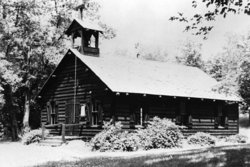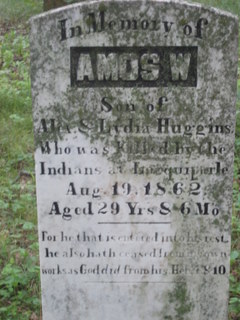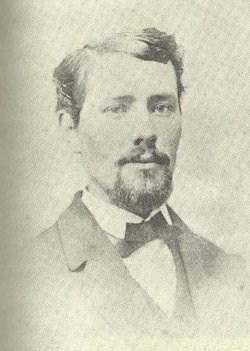In 1856, he married Sophia Josephine Marsh. In the fall of 1861, a substantial school room and dwelling, a storehouse, and blacksmith shop were completed at Lac qui Parle. The storehouse held the supplies the Dakota needed to plant their fields. In early November, Huggins and his wife, son, and daughter occupied the school house dwelling and made it their home.
He ministered among the Dakota people and taught the Indian children who came to the school. He was assisted by Julia LaFramboise, who was a school teacher also. They developed the school to teach the Dakota more than just agrarian methods.
Lac qui Parle was a Dakota Indian village; the Dakota leader of the village at that time was Wakanmane ("Walking Spirit"). A band of hostile Dakota started the Dakota War at the Lower Sioux Agency near Morton on Monday, August 18, 1862. The Dakota who were at war made their way across the Minnesota plains, attacking any whites they could find. If Wankanmane and the other Dakota people of the Lac qui parle village had been at home on August 19, Amos Huggins and his family would have been safe. But while Spirit Walker's people were away, three Indian men came - two from the Lower Agency - and shot and killed Huggins at his house, then plundered his home. His wife and children and teaching assistant Julia LaFramboise were taken captive, but would ultimately survive the war and gain their freedom.
When the Dakota war broke out, Huggins' wife Sophia was pregnant with their third child. He was born in 1863 and was named Amos Williamson Huggins after his father.
At the close of the Dakota War, Amos and his brother Charles went to live with their aunt, Jane Huggins Holtsclaw. Josephine remarried in 1869.
During his adult years, Amos Huggins Jr. wrote of his father:
...my father, and his sister Jane attended Knox College at Galesburg, Illinois. While there he worked his way through college and then taught school...Amos Huggins and his wife moved to Minnesota, where his parents still lived, and took up farming and also assisted at the mission. He had a sweet tenor voice and taught songs to the Indians. My aunt Jane often spoke of her delight in hearing his tenor voice in the song 'Nearer My God To Thee.'
Burial notes:
He was buried on his homestead which was located on the south bank of the Lac qui Parle River, just south of Lac qui Parle Village. The grave is unmarked.
A sign in memory of Huggins is visible on the south side of County Road 20, just east of the Lac qui Parle River bridge (south of Lac qui Parle Village). The sign says "Amos Huggins, Missionary and Teacher to the Indians, Only Victim of Sioux Uprising in Lac qui Parle."
Although there is no marker for his grave locally, a marker cenotaph can be found in the Greenlawn (Traverse) cemetery at St. Peter, Minnesota. Also buried in the same cemetery is his brother, Rufus Huggins, who was injured in the battle of New Ulm and died of his wounds.
Following is the transcription on Amos Huggins' cenotaph:
"Amos W.
Son of
Alex & Lydia Huggins
Who was killed by the
Indians at Lac qui Parle
August 19, 1862
Aged 29 Yrs & 6 Mo.
For He that has entered into his rest, he also hath ceased from his own works as God did from His. Heb 4 & 10."
(c) Copyright 2009 Cindy Coffin
In 1856, he married Sophia Josephine Marsh. In the fall of 1861, a substantial school room and dwelling, a storehouse, and blacksmith shop were completed at Lac qui Parle. The storehouse held the supplies the Dakota needed to plant their fields. In early November, Huggins and his wife, son, and daughter occupied the school house dwelling and made it their home.
He ministered among the Dakota people and taught the Indian children who came to the school. He was assisted by Julia LaFramboise, who was a school teacher also. They developed the school to teach the Dakota more than just agrarian methods.
Lac qui Parle was a Dakota Indian village; the Dakota leader of the village at that time was Wakanmane ("Walking Spirit"). A band of hostile Dakota started the Dakota War at the Lower Sioux Agency near Morton on Monday, August 18, 1862. The Dakota who were at war made their way across the Minnesota plains, attacking any whites they could find. If Wankanmane and the other Dakota people of the Lac qui parle village had been at home on August 19, Amos Huggins and his family would have been safe. But while Spirit Walker's people were away, three Indian men came - two from the Lower Agency - and shot and killed Huggins at his house, then plundered his home. His wife and children and teaching assistant Julia LaFramboise were taken captive, but would ultimately survive the war and gain their freedom.
When the Dakota war broke out, Huggins' wife Sophia was pregnant with their third child. He was born in 1863 and was named Amos Williamson Huggins after his father.
At the close of the Dakota War, Amos and his brother Charles went to live with their aunt, Jane Huggins Holtsclaw. Josephine remarried in 1869.
During his adult years, Amos Huggins Jr. wrote of his father:
...my father, and his sister Jane attended Knox College at Galesburg, Illinois. While there he worked his way through college and then taught school...Amos Huggins and his wife moved to Minnesota, where his parents still lived, and took up farming and also assisted at the mission. He had a sweet tenor voice and taught songs to the Indians. My aunt Jane often spoke of her delight in hearing his tenor voice in the song 'Nearer My God To Thee.'
Burial notes:
He was buried on his homestead which was located on the south bank of the Lac qui Parle River, just south of Lac qui Parle Village. The grave is unmarked.
A sign in memory of Huggins is visible on the south side of County Road 20, just east of the Lac qui Parle River bridge (south of Lac qui Parle Village). The sign says "Amos Huggins, Missionary and Teacher to the Indians, Only Victim of Sioux Uprising in Lac qui Parle."
Although there is no marker for his grave locally, a marker cenotaph can be found in the Greenlawn (Traverse) cemetery at St. Peter, Minnesota. Also buried in the same cemetery is his brother, Rufus Huggins, who was injured in the battle of New Ulm and died of his wounds.
Following is the transcription on Amos Huggins' cenotaph:
"Amos W.
Son of
Alex & Lydia Huggins
Who was killed by the
Indians at Lac qui Parle
August 19, 1862
Aged 29 Yrs & 6 Mo.
For He that has entered into his rest, he also hath ceased from his own works as God did from His. Heb 4 & 10."
(c) Copyright 2009 Cindy Coffin
Inscription
In memory of _ Son of Ale
Gravesite Details
The eldest sons of Alexander Huggins, one of the oldest missionaries for the Sioux, was a govt. teacher at Lac Qui Parle and was shot at his house in the presence of his wife and children.
Family Members
Advertisement
Explore more
Sponsored by Ancestry
Advertisement

















